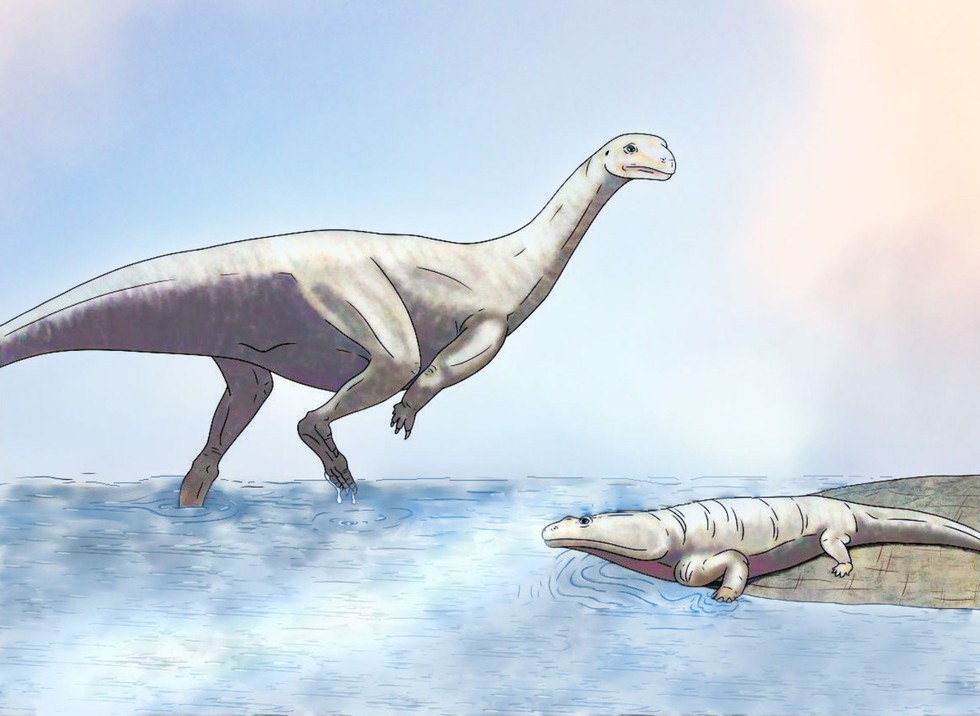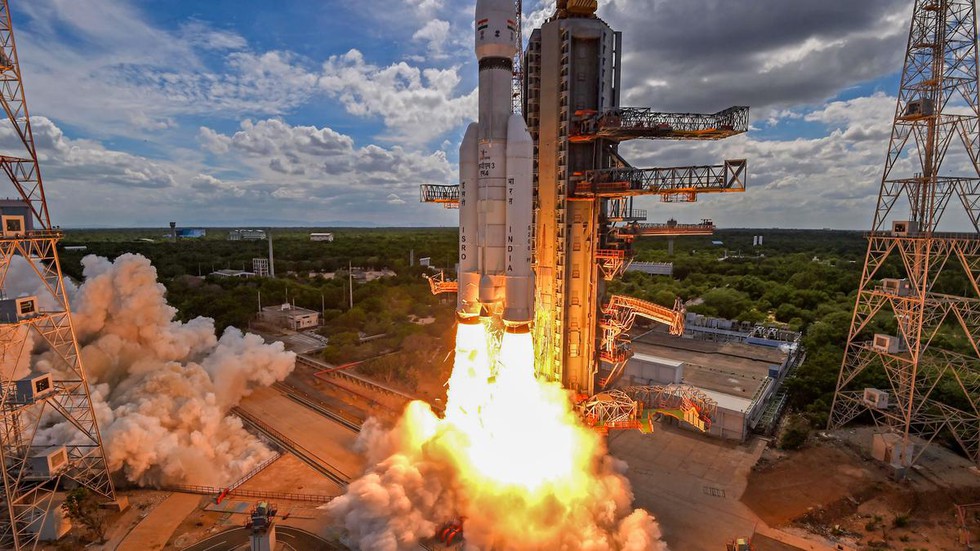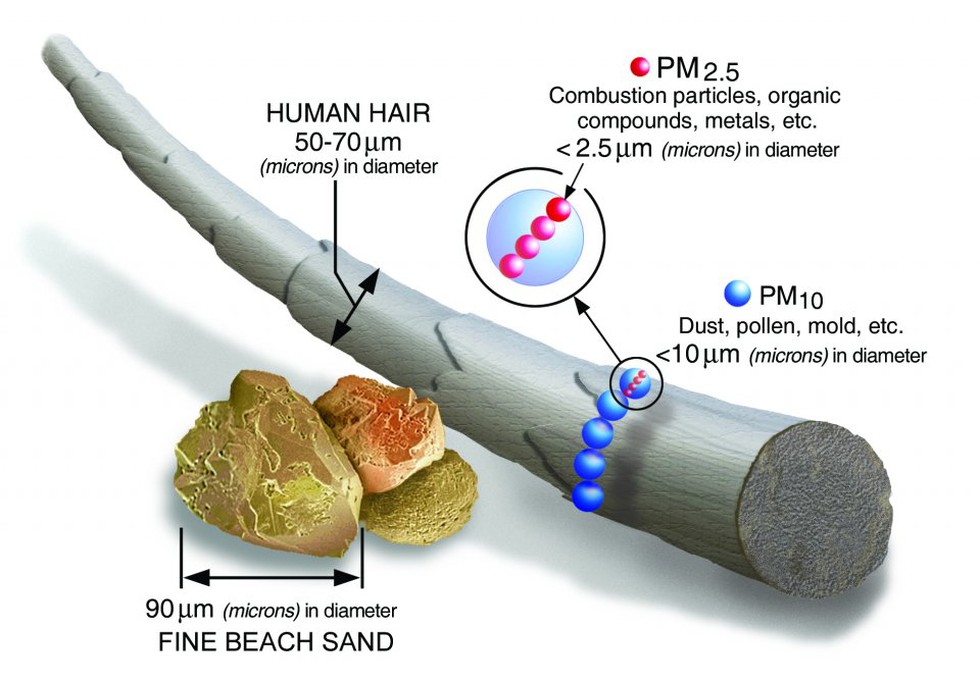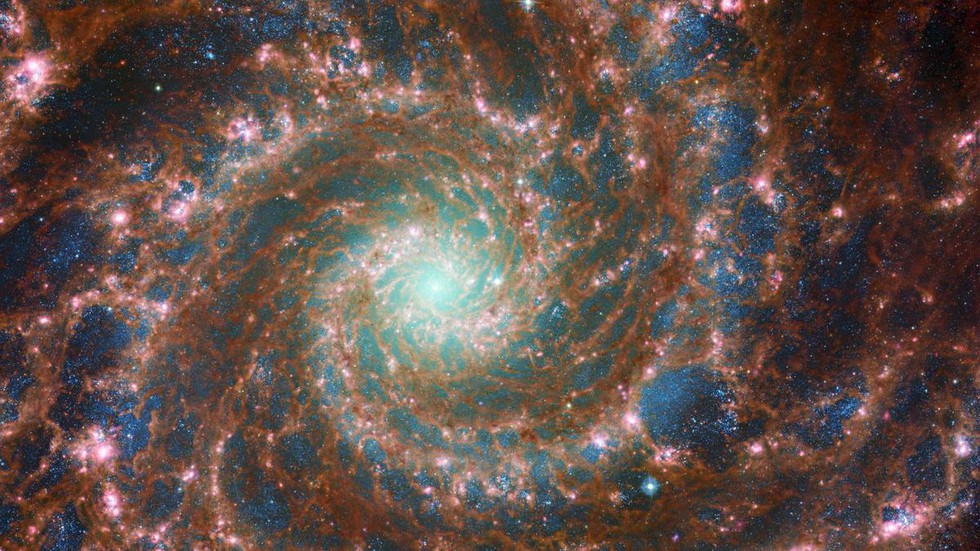 About Musankwa sanyatiensis:
About Musankwa sanyatiensis:- It is a new dinosaur species which has been identified from fossils discovered along the shores of Lake Kariba in Zimbabwe.
- The dinosaur’s genus name, “Musankwa,” was the name of the houseboat scientists used during their expeditions to the research site.
- In addition, its species name, “sanyatiensis,” alludes to the Sanyati River that flows into Lake Kariba.
- It is the first dinosaur to be named from the Mid-Zambezi Basin of northern Zimbabwe in over 50 years.
- Additionally, it is only the fourth dinosaur to be named from Zimbabwe, following the descriptions of "Syntarsus" rhodesiensis in 1969, Vulcanodon karibaensis in 1972, and, most recently, Mbiresaurus raathi in 2022.
- The rocks yielding this new specimen date back to the Late Triassic period, approximately 210 million years ago.
- Musankwa sanyatiensis is represented by the remains of a single hind leg, including its thigh, shin, and ankle bones.
- Evolutionary analysis reveals that it was a member of the Sauropodomorpha, a group of bipedal, long-necked dinosaurs that were widespread during the Late Triassic.
- Interestingly, it appears to be closely related to contemporaries in South Africa and Argentina.
- Weighing in at around 390 kg, the plant-eating Musankwa sanyatiensis was one of the larger dinosaurs of its era and mostly lived in swamp areas.
 About Maharani Temple:
About Maharani Temple:- It is situated on a small hillock in the heart of Gulmarg town in the Baramulla district of Jammu and Kashmir.
- Also known as the Rani Temple or Mohineshwar Shivalaya, the temple is dedicated to Lord Shiva and his consort, Parvati.
- It was constructed by Mohini Bai Sisodia, wife of the former ruler of Kashmir, Maharaja Hari Singh, in 1915.
- This temple was once a royal temple of the Dogra dynasty of the erstwhile princely state of Jammu and Kashmir.
- It has been constructed in such a way that it can be seen from all corners of Gulmarg.
- The temple's intricate carvings and designs reflect a beautiful blend of Indian and Persian styles.
- It is an example of religions intertwined with a Muslim priest performing rituals in the temple.
- The Indian Army collaborated with local communities in 2021 to restore this 106-year-old temple. Apart from renovating the temple structure, the Indian Army also undertook the redesigning of pathways leading to the temple.
 About Thismia malayana:
About Thismia malayana:- It is a new species of plant discovered in the tropical rainforests of Peninsular Malaysia.
- It belongs to a group of plants known as mycoheterotrophs.
- Unlike most plants, mycoheterotrophs do not perform photosynthesis.
- Instead, they act as parasites, stealing carbon resources from the fungi on their roots.
- This adaptation takes advantage of the mycorrhizal symbiosis, which is usually a mutually beneficial relationship between colonizing fungi and a plant’s root system.
- What happens in mycorrhizal symbiosis?
- The fungi help the tree absorb water and nutrients from the soil, while the tree provides the fungi with sugars produced through photosynthesis.
- This symbiotic partnership is vital for the health and growth of both organisms.
- But Thismia malayana, instead of contributing to the exchange, acts as a parasite, siphoning off carbon resources from the fungi without offering anything in return.
- By stealing nutrients from fungi, this newly discovered species thrives in the low-light conditions of dense forest understories, where its highly specialised flowers are pollinated by fungus gnats and other small insects.
- The unusual plant is around 2 cm long and is typically found hidden in leaf litter and growing near tree roots or old rotten logs.
- Despite its small size, Thismia malayana is very sensitive to environmental changes and has been classified as Vulnerable according to the IUCN Red List.

About PraVaHa Software:
- Parallel RANS Solver for Aerospace Vehicle Aero-thermo-dynamic Analysis (PraVaHa) is a Computational Fluid Dynamics (CFD) software developed in ISRO’s Vikram Sarabhai Space Centre (VSSC).
- It can simulate external and internal flows on launch vehicles, winged and non-winged re-entry vehicles.
- PraVaHa has been extensively used in the Gaganyaan program for aerodynamic analysis of human-rated launch vehicles, viz, HLVM3, Crew Escape System (CES), and Crew Module (CM).
- The software is secure and flexible enough to support collaborative development with academic institutions and government labs.
- Currently, the PraVaHa code is operational to simulate airflow for Perfect Gas and Real Gas conditions.
- Validations of the code are underway for simulating the effects of chemical reactions that occur during air dissociation upon ‘earth re-entry’ and ‘combustion’ as in scramjet vehicles.
- PraVaHa is expected to replace most of the CFD simulations for aero characterisation, which are currently being carried out using commercial software.
- Besides, this software is expected to help academia and other institutions engaged in the design of missiles, aircraft, and rockets to find solutions to complex aerodynamic problems.
Importance of Computational Fluid Dynamics (CFD):
- Initial aerodynamic design studies for launch vehicles demand evaluation of a large number of configurations.
- Any aerospace vehicle moving through the Earth’s atmosphere during launch or reentry is subjected to severe aerodynamic and aerothermal loads in terms of external pressure and heat flux.
- Understanding the airflow around aircraft, rocket bodies, or CM during earth re-entry is essential to design the shape, structure, and Thermal Protection System (TPS) required for these bodies.
- The unsteady part of aerodynamics contributes to serious flow issues around such rocket bodies and creates significant acoustic noise during the mission.
- CFD is one such tool to predict the aerodynamic and aerothermal loads, which solve numerically the equations of conservation of mass, momentum, and energy along with the equation of state.

About Tele-MANAS:
- The Tele Mental Health Assistance and Networking Across States (Tele-MANAS) initiative was launched by the Ministry of Health and Family Welfare in October 2022.
- It aims to provide free tele-mental health services all over the country round the clock, particularly to people in remote or underserved areas.
- Tele-MANAS will be organised in a two-tier system:
- Tier 1 comprises state Tele-MANAS cells, which include trained counsellors and mental health specialists.
- Tier 2 will comprise specialists at the District Mental Health Programme (DMHP)/Medical College resources for physical consultation and/or e-Sanjeevani for audio-visual consultation.
- Currently, there are 51 operational Tele-MANAS cells functioning across all 36 States and UTs, offering services in 20 different languages.
- A toll-free, 24/7 helpline number (14416) is available as part of the initiative, allowing callers to select the language of choice for availing services. The service is also accessible at 1-800-891-4416.
- This call will be an Interactive Voice Response system (IVRS) based audio call only, with a timely auto-call back approach.
- Through the automated callback service, the caller will first be attended to by a trained counsellor.
- Based on the level of care required, the counsellor will either provide the care needed within their capabilities or refer the caller for specialist care.
- If the caller requires specialized care, the call will be handled by a mental health specialist (clinical psychologist, psychiatric social worker, psychiatric nurse, or psychiatrist). This level of service will contain both audio- and video-based options.
- In case the caller requires urgent in-person intervention/complex evaluations and management, they will be referred to the nearest in-person service for a physical consultation, and/or an audio-visual consultation with a specialist will be arranged through eSanjeevani.
- These centers will range from Health and Wellness Centre (HWCs) to tertiary care centers as part of the DMHP.
About UNESCO State of Ocean Report:
- The UNESCO ‘State of the Ocean Report’, initiated by the Intergovernmental Oceanographic Commission (IOC-UNESCO) during the 2022 United Nations Ocean Conference, serves as an accessible overview of the ocean's current status.
- It supports the monitoring of the UN Decade of Ocean Science for Sustainable Development (2021–2030) and encourages actions towards a sustainable ocean future.
- The inaugural 2022 edition featured insights from over 100 marine science experts across various fields including ocean acidification, pollution, and tsunami warning.
- This report, and its subsequent annual editions released on World Oceans Day (June 8), aligns with the seven outcomes of the UN Ocean Decade.
- The key finding of the report
- The upper 2,000 meters of the oceans have experienced significant warming, with the rate increasing from 0.32 ± 0.03 watt per square meter (W/m²) from 1960 to 2023 to 0.66 ± 0.10 W/m² in the last two decades.
- Oceans are absorbing about 90% of the Earth's excess energy, causing increased deoxygenation and threatening marine ecosystems and human economies dependent on them.
- Ocean acidification is on the rise globally, particularly in the open ocean, with a noted pH decline since the late 1980s; more comprehensive data from coastal areas is needed.
- Sea levels have risen consistently since 1993, necessitating improved monitoring systems at all scales.
- There's growing interest in marine carbon dioxide removal (mCDR) technologies, but their ecological impacts and effectiveness remain uncertain.

About Special Category Status (SCS):
- In 1969, the Fifth Finance Commission of India introduced the Special Category Status to aid certain states in their development and accelerate growth if they faced historical economic or geographical disadvantages.
Criteria:
- Factors considered for granting Special Category Status included challenging and hilly terrain, low population density, a significant tribal population, strategic border location, economic and infrastructural backwardness and non-viable state finances.
- However, the system was discontinued based on the recommendation of the 14th Finance Commission, which proposed addressing the resource gap of states by increasing the tax devolution from 32% to 42%.
Benefits for States under SCS:
- The Centre pays 90% of the funds required in centrally-sponsored schemes, compared to 60% or 75% for other states.
- Preferential treatment in getting central funds assistance, concession on excise duty to attract industries to the state, a significant 30% of the Centre’s gross budget goes to the special category states etc.
States under Special Category Status
- Currently, eleven states have the Special Category Status in the country including Assam, Nagaland, Himachal Pradesh, Manipur, Meghalaya, Sikkim, Tripura, Arunachal Pradesh, Mizoram, Uttarakhand, and Telangana.

About the ‘Air of the Anthropocene’ initiative:
- The "Air of the Anthropocene" project is an international initiative combining art and science to visualise air pollution through light painting.
- Artists and researchers collaborated to produce photographic evidence using digital light painting techniques and low-cost air pollution sensors.
What is Particulate Matter?
- Particulate matter (PM) is a complex mixture of small solid particles and liquid droplets suspended in the air. It includes both organic and inorganic particles such as dust, pollen, soot, smoke and liquid droplets, which vary greatly in size, composition and origin.
Impact of Air Pollution:
- Impact on Public Health: Particulate matter, particularly 5, is linked to severe health issues, including cardiovascular diseases, stroke and respiratory illnesses. It is a leading cause of morbidity and mortality worldwide.
The World Health Organisation (WHO) estimates that 99% of the global population breathes air that exceeds WHO guideline limits, with about 7 million premature deaths annually linked to air pollution.

About MOND:
- Galaxies rotate much faster than predicted by applying Newton’s law of gravity to their visible matter.
- To explain this, some additional gravity is needed. This is why the idea of dark matter was first proposed.
- Milgromian dynamics, also known as Modified Newtonian Dynamics (MOND), is an alternative theory to explain the dynamics of galaxies without invoking dark matter.
- It was proposed by Mordehai Milgrom in 1983.
- It suggests that Newtonian physics breaks down at very low accelerations (as seen at the edges of galaxies) altering gravitational behaviour without the need for dark matter.
- Why has this theory failed?
- MOND predicts noticeable gravitational effects at small scales, but tests involving Saturn's orbit during the Cassini mission showed no anomalies, supporting Newtonian gravity over MOND in the solar system.
- MOND theory has also faced failures in its inability to explain galaxy clusters, wide binary stars and cosmic microwave background radiation, as well as its lack of a relativistic framework.
What is dark matter?
- Dark matter is a hypothetical form of matter that does not interact with light or the electromagnetic field, but its presence is inferred by its gravitational effects on visible matter.
- It emits no light or energy and thus cannot be detected by conventional sensors and detectors.

Bird Flu
- About:
- Bird flu, or avian flu, is an infectious viral disease caused by the Avian Influenza A virus.
- It mainly infects and spreads among poultry and some wild birds.
- Occasionally, a form of the flu virus jumps from wild birds to poultry farms.
- It then quickly evolves into a highly pathogenic flu virus that causes a larger wave of illness and death among birds.
- Avian influenza can also infect humans due to direct contact with infected birds or contaminated environments.
About H5N2 Bird flu:
- H5N2 is a subtype of the Avian Influenza A virus.
- Influenza A viruses are categorised by subtypes based on the proteins on their surfaces.
- There are 18 different hemagglutinin (H) and 11 different neuraminidase (N) subtypes, including H5N2.
- Hemagglutinin is a glycoprotein found on the surface of influenza viruses and neuraminidase is an enzyme found on the surface of the viruses that enable them to be released from the host cell.
- H5N2 has been first reported in poultry in Mexico.
- Reasons Behind Spread:
- While specific reasons for large-scale outbreaks of H5N2 are not well-established, factors like migratory bird patterns and interactions with domestic birds contribute to its spread.
- Changes in environmental conditions, similar to those affecting H5N1, could influence the spread of H5N2 by altering bird migratory routes and behaviours.
- Spread of H5N2 to Humans: Although human infections with H5N2 are rare, the potential for the virus to mutate and become more easily transmissible between humans while retaining its severity poses a significant public health risk.
- Health Effects: Avian influenza virus infections in humans may cause mild to severe upper respiratory tract infections and can be fatal.
- Conjunctivitis, gastrointestinal symptoms, encephalitis and encephalopathy have also been reported.
- Diagnosis: The disease is diagnosed using molecular methods like Real-Time Polymerase Chain Reaction (RT-PCR).
- Treatment: Antiviral drugs, notably neuraminidase inhibitors (oseltamivir, zanamivir) can reduce the duration of viral replication.


























































































































































.png)
.png)
.png)
.png)
.png)


.png)
.png)
.png)





.png)
.png)






.png)
.png)
.png)
.png)
.png)
.png)
.png)
.png)
.png)

.png)







.png)
.png)


.png)
.png)
.png)


.png)

.png)
.png)





.jpg)

.png)
.png)


.png)

.png)
.png)
.png)

.jpg)

.jpg)


.png)

.png)
.png)
.png)
.png)
.png)
.png)
.png)
.png)
.png)
.png)




.png)

.png)





.png)
.png)
.png)
.png)
.png)
.png)
.png)
.png)
.png)
.png)
.jpg)
.jpg)

.png)
.png)
.png)
.png)
.png)
.png)
.png)
.png)
.png)
.png)
.png)
.png)
.png)
.png)
.png)
.png)
.png)
.png)
.png)
.png)
.png)
.png)



.png)
.png)

.jpg)
.jpg)


.jpg)
.jpg)
.jpg)
.jpg)
.jpg)

.jpg)








.jpg)
.jpg)
.jpg)
.jpg)
.jpg)

















.jpg)
.jpg)







.jpg)


















.jpg)
.jpg)






























































































.jpg)
.jpg)


























.jpg)

.jpg)










.jpg)








.jpg)




.jpg)










.jpg)


















.jpg)












































.jpg)














.jpg)
.jpg)
.jpg)





.jpg)

.jpg)
.jpg)





































































.jpg)


































.jpg)
.jpg)
















































.jpg)












.jpg)


.jpg)




.jpg)
.jpg)
.jpg)

.jpg)
.jpg)
.jpg)
.jpg)

.jpg)
.jpg)
.jpg)

.jpg)
.jpg)
.jpg)
.jpg)
.jpg)
.jpg)
.jpg)
.jpg)

.jpg)


.jpg)
.jpg)
.jpg)
.jpg)
.jpg)
.jpg)
.jpg)
.jpg)
.jpg)
.jpg)











.jpg)
.jpg)





.jpg)
.jpg)
.jpg)
























.jpg)
























.jpg)









.jpg)
.jpg)







.jpg)
.jpg)









































.jpg)
.jpg)
.jpg)
.jpg)
.jpg)

.jpg)
.jpg)
.jpg)
.jpg)
.jpg)


.jpg)
.jpg)
.jpg)
.jpg)
.jpg)

.jpg)
.jpg)
.jpg)
.jpg)
.jpg)
.jpg)
.jpg)
.jpg)
.jpg)
.jpg)
.png)

.png)
.png)

.png)
.png)
.png)
.png)


.jpg)
.jpg)

.jpg)
.jpg)
.jpg)

.png)
.png)
.png)
.png)
.png)
.png)
.png)

.png)
.png)
.png)
.png)
.png)
.png)
.png)
.png)
.png)
.png)





































































-min.png)



.png)




.png)








































